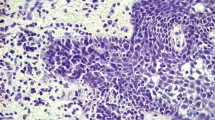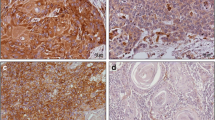Abstract
Podoplanin, a type I transmembrane glycoprotein with an effect of platelet aggregation, has been reported to be one of the possible prognostic factors of oral squamous cell carcinoma (OSCC). However, the biological significance of podoplanin is largely unclear. The aim of this study was to develop a practical model for the prediction of prognosis using the grade of podoplanin expression, and also to evaluate the biological function of podoplanin. Eighty-two specimens of patients with previously untreated OSCC, who underwent either biopsy or surgery, were histopathologically and immunohistochemically analyzed. These 82 cases were composed of 66 well-differentiated, 10 moderately differentiated and 6 poorly differentiated OSCC. Podoplanin was successfully immunostained in 78 specimens, and was detected in most cases, but the frequency of positive cells varied. The prognosis of patients with more than 50 % podoplanin-positive tumor cells was significantly poorer than that of the other patients. Multivariate hazards regression analysis suggested that a linear combination of covariates, OSCC patients with more or less than 50 % podoplanin expression, age of more or less than 70 years old, mode of invasion and T3, T4 or T2 versus T1 of the UICC T-stage classification was the most effective model for evaluating the prognosis of OSCC patients. Additionally, podoplanin expression had a significant relationship to UICC clinical stage and the expression of Ki-67. An effective regression model using podoplanin expression was developed for evaluating the prognosis of OSCC and the biological significance of podoplanin was suggested to be associated with the growth and/or progression of OSCC.



Similar content being viewed by others
Abbreviations
- OSCC:
-
Oral squamous cell carcinoma
- VEGF:
-
Vascular endothelial growth factor
- AIC:
-
Akaike’s information criterion
- RR:
-
Relative risk
References
Toyoshima M, Nakajima M, Yamori T, Tsuruo T (1995) Purification and characterization of the platelet-aggregating sialoglycoprotein gp44 expressed by highly metastatic variant cells of mouse colon adenocarcinoma 26. Cancer Res 55(4):767–773
Kato Y, Fujita N, Kunita A, Sato S, Kaneko M, Osawa M, Tsuruo T (2003) Molecular identification of Aggrus/T1alpha as a platelet aggregation-inducing factor expressed in colorectal tumors. J Biol Chem 278(51):51599–51605. doi:10.1074/jbc.M309935200
Breiteneder-Geleff S, Soleiman A, Kowalski H, Horvat R, Amann G, Kriehuber E, Diem K, Weninger W, Tschachler E, Alitalo K, Kerjaschki D (1999) Angiosarcomas express mixed endothelial phenotypes of blood and lymphatic capillaries: podoplanin as a specific marker for lymphatic endothelium. Am J Pathol 154(2):385–394. doi:10.1016/s0002-9440(10)65285-6
Schacht V, Ramirez MI, Hong YK, Hirakawa S, Feng D, Harvey N, Williams M, Dvorak AM, Dvorak HF, Oliver G, Detmar M (2003) T1alpha/podoplanin deficiency disrupts normal lymphatic vasculature formation and causes lymphedema. EMBO J 22(14):3546–3556. doi:10.1093/emboj/cdg342
Martin-Villar E, Scholl FG, Gamallo C, Yurrita MM, Munoz-Guerra M, Cruces J, Quintanilla M (2005) Characterization of human PA2.26 antigen (T1alpha-2, podoplanin), a small membrane mucin induced in oral squamous cell carcinomas. Int J Cancer 113(6):899–910. doi:10.1002/ijc.20656
Yuan P, Temam S, El-Naggar A, Zhou X, Liu DD, Lee JJ, Mao L (2006) Overexpression of podoplanin in oral cancer and its association with poor clinical outcome. Cancer 107(3):563–569. doi:10.1002/cncr.22061
Kreppel M, Drebber U, Wedemeyer I, Eich HT, Backhaus T, Zoller JE, Scheer M (2011) Podoplanin expression predicts prognosis in patients with oral squamous cell carcinoma treated with neoadjuvant radiochemotherapy. Oral Oncol 47(9):873–878. doi:10.1016/j.oraloncology.2011.06.508
Kreppel M, Scheer M, Drebber U, Ritter L, Zoller JE (2010) Impact of podoplanin expression in oral squamous cell carcinoma: clinical and histopathologic correlations. Virchows Arch 456(5):473–482. doi:10.1007/s00428-010-0915-7
Bartuli FN, Luciani F, Caddeo F, Compagni S, Piva P, Ottria L, Arcuri C (2012) Podoplanin in the development and progression of oral cavity cancer: a preliminary study. Oral Implantol (Rome) 5(2–3):33–41
Funayama A, Cheng J, Maruyama S, Yamazaki M, Kobayashi T, Syafriadi M, Kundu S, Shingaki S, Saito C, Saku T (2011) Enhanced expression of podoplanin in oral carcinomas in situ and squamous cell carcinomas. Pathobiology 78(3):171–180. doi:10.1159/000324926
Kato Y, Kaneko M, Sata M, Fujita N, Tsuruo T, Osawa M (2005) Enhanced expression of Aggrus (T1alpha/podoplanin), a platelet-aggregation-inducing factor in lung squamous cell carcinoma. Tumour Biol 26(4):195–200. doi:10.1159/000086952
Kato Y, Sasagawa I, Kaneko M, Osawa M, Fujita N, Tsuruo T (2004) Aggrus: a diagnostic marker that distinguishes seminoma from embryonal carcinoma in testicular germ cell tumors. Oncogene 23(52):8552–8556. doi:10.1038/sj.onc.1207869
Shibahara J, Kashima T, Kikuchi Y, Kunita A, Fukayama M (2006) Podoplanin is expressed in subsets of tumors of the central nervous system. Virchows Arch 448(4):493–499. doi:10.1007/s00428-005-0133-x
Wu HM, Ren GX, Wang LZ, Zhang CY, Chen WT, Guo W (2012) Expression of podoplanin in salivary gland adenoid cystic carcinoma and its association with distant metastasis and clinical outcomes. Mol Med Report 6(2):271–274. doi:10.3892/mmr.2012.911
Xu Y, Ogose A, Kawashima H, Hotta T, Ariizumi T, Li G, Umezu H, Endo N (2011) High-level expression of podoplanin in benign and malignant soft tissue tumors: immunohistochemical and quantitative real-time RT-PCR analysis. Oncol Rep 25(3):599–607. doi:10.3892/or.2011.1141
Ariizumi T, Ogose A, Kawashima H, Hotta T, Li G, Xu Y, Umezu H, Sugai M, Endo N (2010) Expression of podoplanin in human bone and bone tumors: New marker of osteogenic and chondrogenic bone tumors. Pathol Int 60(3):193–202. doi:10.1111/j.1440-1827.2009.02510.x
Zustin J, Scheuer HA, Friedrich RE (2010) Podoplanin expression in human tooth germ tissues and cystic odontogenic lesions: an immunohistochemical study. J Oral Pathol Med 39(1):115–120. doi:10.1111/j.1600-0714.2009.00853.x
Gonzalez-Alva P, Tanaka A, Oku Y, Miyazaki Y, Okamoto E, Fujinami M, Yoshida N, Kikuchi K, Ide F, Sakashita H, Kusama K (2010) Enhanced expression of podoplanin in ameloblastomas. J Oral Pathol Med 39(1):103–109. doi:10.1111/j.1600-0714.2009.00818.x
Padgett DM, Cathro HP, Wick MR, Mills SE (2008) Podoplanin is a better immunohistochemical marker for sarcomatoid mesothelioma than calretinin. Am J Surg Pathol 32(1):123–127. doi:10.1097/PAS.0b013e31814faacf
Tateyama H, Sugiura H, Yamatani C, Yano M (2011) Expression of podoplanin in thymoma: its correlation with tumor invasion, nodal metastasis, and poor clinical outcome. Hum Pathol 42(4):533–540. doi:10.1016/j.humpath.2010.08.012
Tong L, Yuan S, Feng F, Zhang H (2012) Role of podoplanin expression in esophageal squamous cell carcinoma: a retrospective study. Dis Esophagus 25(1):72–80. doi:10.1111/j.1442-2050.2011.01211.x
Rodrigo JP, Garcia-Carracedo D, Gonzalez MV, Mancebo G, Fresno MF, Garcia-Pedrero J (2010) Podoplanin expression in the development and progression of laryngeal squamous cell carcinomas. Mol Cancer 9:48. doi:10.1186/1476-4598-9-48
Suzuki H, Onimaru M, Koga T, Takeshita M, Yano T, Maehara Y, Nakamura S, Sueishi K (2011) High podoplanin expression in cancer cells predicts lower incidence of nodal metastasis in patients with lung squamous cell carcinoma. Pathol Res Pract 207(2):111–115. doi:10.1016/j.prp.2010.11.006
Seki S, Fujiwara M, Matsuura M, Fujita S, Ikeda H, Asahina I, Ikeda T (2011) Prediction of outcome of patients with oral squamous cell carcinoma using vascular invasion and the strongly positive expression of vascular endothelial growth factors. Oral Oncol 47(7):588–593. doi:10.1016/j.oraloncology.2011.04.013
Jakobsson PA, Eneroth CM, Killander D, Moberger G, Martensson B (1973) Histologic classification and grading of malignancy in carcinoma of the larynx. Acta Radiol Ther Phys Biol 12(1):1–8
Schacht V, Dadras SS, Johnson LA, Jackson DG, Hong YK, Detmar M (2005) Up-regulation of the lymphatic marker podoplanin, a mucin-type transmembrane glycoprotein, in human squamous cell carcinomas and germ cell tumors. Am J Pathol 166(3):913–921. doi:10.1016/s0002-9440(10)62311-5
Akaike H (1973) Information theory and an extention of the maximum likelihood principle. 2nd International Symposium on Information Theory. Budapest. First published
Ihaka R, Gentleman R (1996) R: a language for data analysis and graphics. J Comp Graph Stat 5:299–314
Astarita JL, Acton SE, Turley SJ (2012) Podoplanin: emerging functions in development, the immune system, and cancer. Front Immunol 3:283. doi:10.3389/fimmu.2012.00283
Cueni LN, Hegyi I, Shin JW, Albinger-Hegyi A, Gruber S, Kunstfeld R, Moch H, Detmar M (2010) Tumor lymphangiogenesis and metastasis to lymph nodes induced by cancer cell expression of podoplanin. Am J Pathol 177(2):1004–1016. doi:10.2353/ajpath.2010.090703
Klimowicz AC, Bose P, Nakoneshny SC, Dean M, Huang L, Chandarana S, Magliocco AM, Wayne Matthews T, Brockton NT, Dort JC (2012) Basal Ki67 expression measured by digital image analysis is optimal for prognostication in oral squamous cell carcinoma. Eur J Cancer 48(14):2166–2174. doi:10.1016/j.ejca.2012.04.010
Mashhadiabbas F, Mahjour F, Mahjour SB, Fereidooni F, Hosseini FS (2012) The immunohistochemical characterization of MMP-2, MMP-10, TIMP-1, TIMP-2, and podoplanin in oral squamous cell carcinoma. Oral Surg Oral Med Oral Pathol Oral Radiol 114(2):240–250. doi:10.1016/j.oooo.2012.04.009
Kawaguchi H, El-Naggar AK, Papadimitrakopoulou V, Ren H, Fan YH, Feng L, Lee JJ, Kim E, Hong WK, Lippman SM, Mao L (2008) Podoplanin: a novel marker for oral cancer risk in patients with oral premalignancy. J Clin Oncol 26(3):354–360. doi:10.1200/jco.2007.13.4072
Atsumi N, Ishii G, Kojima M, Sanada M, Fujii S, Ochiai A (2008) Podoplanin, a novel marker of tumor-initiating cells in human squamous cell carcinoma A431. Biochem Biophys Res Commun 373(1):36–41. doi:10.1016/j.bbrc.2008.05.163
Acknowledgments
This study was supported by Grants-in-Aid from the Ministry of Education, Culture, Sports and Technology of Japan (Grant no. 25462865) and the Nagasaki University research fund for the Department of Oral Pathology.
Author information
Authors and Affiliations
Corresponding author
Rights and permissions
About this article
Cite this article
Seki, S., Fujiwara, M., Matsuura, M. et al. Prognostic Value of Podoplanin Expression in Oral Squamous Cell Carcinoma―A Regression Model Auxiliary to UICC Classification. Pathol. Oncol. Res. 20, 521–528 (2014). https://doi.org/10.1007/s12253-013-9723-0
Received:
Accepted:
Published:
Issue Date:
DOI: https://doi.org/10.1007/s12253-013-9723-0




